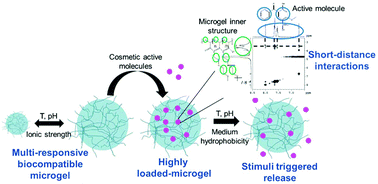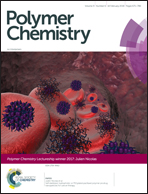Dual-responsive biocompatible microgels as high loaded cargo: understanding of encapsulation/release driving forces by NMR NOESY†
Abstract
Herein, cosmetic active molecule controlled encapsulation and release from multi-responsive oligo(ethylene glycol)-based biocompatible microgels are reported. The pH-responsiveness and pH-sensitive thermal-behavior of the microgel synthesized in different cosmetic buffered media has been demonstrated. The effective encapsulation of four different cosmetic active molecules (two hydrophilic and two hydrophobic) via short-distance local hydrophobic interactions and hydrogen-bonding interactions between the –OH groups of active molecules and ether oxygens of loaded-microgel particles has been studied by Diffusion Ordered Spectroscopy NMR (DOSY-NMR) and Nuclear Overhauser Enhancement Spectroscopy (NOESY-NMR) for the first time. In vitro release profiles have shown that cosmetic active molecule release can be controlled by the pH and temperature of the medium as well as by the medium hydrophobicity. In addition, under those conditions where microgel particles are swollen, the cosmetic active molecule release is controlled by Fickian diffusion and Case-II transport, the diffusional process being dominant. These results indicate that multi-responsive oligo(ethylene glycol)-based microgels are new potential vehicles to design cosmetic active delivery systems.



 Please wait while we load your content...
Please wait while we load your content...